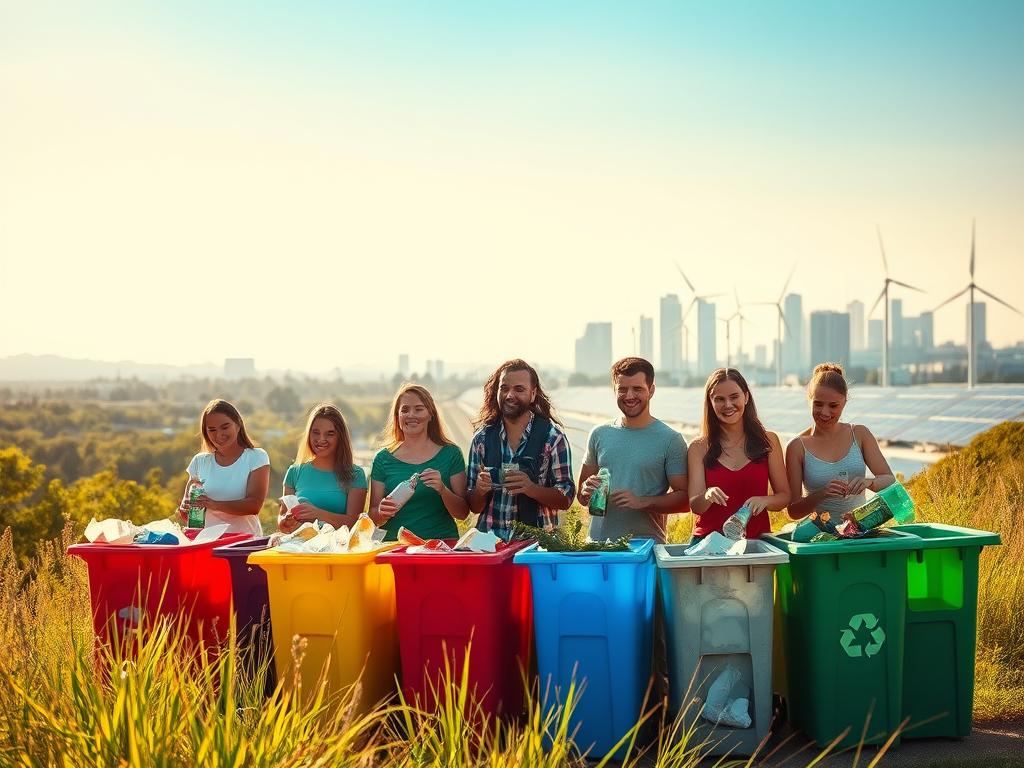Recycling is vital for environmental conservation. The Environmental Protection Agency reports that Americans recycle only 34% of their waste. The remaining 66% burdens our landfills, causing ecological problems.
Recycling benefits go beyond waste reduction. In 2017, humans used a year’s natural resources in just seven months. This highlights the urgent need for sustainable practices to conserve resources.
Landfill waste composition reveals recycling opportunities. In 2014, it included food waste (21%), paper (14%), and plastic (18%). These categories offer chances for better resource management.
Recycling transforms waste into reusable materials. This process reduces energy consumption and preserves natural resources. It also helps to lessen the strain on our planet’s ecosystems.
Understanding Recycling and Resource Conservation
Recycling safeguards our planet’s fragile ecosystem. The recycling process turns waste into valuable resources. This helps conserve our environment and reduce global resource use.
Modern societies create vast amounts of waste. Global consumption of natural resources has tripled since 1970. As we face environmental challenges, grasping resource conservation becomes vital.
The Recycling Process Explained
Recycling involves key stages that transform used materials into new products. This approach minimises waste and supports resource conservation efforts.
- Collection of recyclable materials
- Sorting and separating different material types
- Cleaning and preparing materials for processing
- Breaking down materials into raw components
- Manufacturing new products from recycled materials
Types of Recyclable Materials
Various recyclable materials aid resource conservation uniquely. Some main categories include:
- Aluminium: One ton recycled saves up to 8 tons of bauxite ore
- Paper: Reduces logging and preserves forest habitats
- Plastics: Minimises petroleum-based material production
- Glass: Reduces raw material extraction and energy consumption
Conservation of Natural Resources
Recycling greatly reduces the need for extracting and processing raw materials. Reusing resources significantly decreases environmental impact.
Manufacturers can cut energy use by 30% to 90% when using recycled materials. This is compared to using virgin resources.
Recycling is not just about waste management—it’s about preserving our planet for future generations.
What are the Positive Effects of Recycling?
Recycling does more than just manage waste. It greatly helps our environment and economy. By turning old items into new ones, we save resources and support sustainable growth.
The benefits of recycling can be seen in many ways:
- Environmental Protection: Recycling cuts down pollution and harmful gases
- Energy Conservation: Using recycled materials needs less energy than getting new raw materials
- Economic Stimulus: The recycling industry provides jobs for over 1.1 million people in the United States
Let’s look at some amazing facts about recycling:
- Recycling aluminium saves up to 95% of energy compared to making new aluminium
- Recycling paper saves about 17 trees for each tonne recycled
- One recycled glass bottle can power a 100-watt light bulb for four hours
- Recycling plastic cuts harmful gases by 1.5 to 2.5 times
Towns with good recycling plans can boost their recycling rates by 30% to 50%. This means less waste in landfills.
These efforts also create a circular economy. This type of economy makes jobs and saves natural resources.
Environmental Benefits of Different Recycling Streams
Recycling is vital for environmental conservation. It reduces energy use and ecological impact. Different materials offer unique advantages when recycled.
Aluminium and Metal Recycling Impact
Aluminium recycling is an exceptional environmental solution. It uses 95% less energy than production from virgin sources. Each recycled can saves significant energy, powering devices for long periods.
- Recycled aluminum saves 95% of energy required for new production
- Steel recycling reduces energy consumption by 60%
- Metal recycling significantly reduces mining and extraction processes
Paper and Cardboard Conservation
Paper recycling offers substantial environmental benefits. One tonne of recycled paper saves about 7,000 gallons of water. It also reduces air pollution by 74%.
Cardboard recycling contributes to forest conservation and resource management. It helps preserve our natural ecosystems for future generations.
| Recycling Metric | Paper Impact |
|---|---|
| Water Saved | 7,000 gallons per tonne |
| Air Pollution Reduction | 74% |
| Energy Conservation | 40% less than virgin production |
Plastic and Glass Recycling Benefits
Plastic and glass recycling are crucial for waste reduction. Plastic recycling uses 70% less energy than making new plastics. Glass recycling consumes 40% less energy than virgin material production.
- Only 9% of plastic waste has been historically recycled
- High-density polyethylene (HDPE) and polyethylene terephthalate (PET) are widely recyclable
- Effective recycling can reduce greenhouse gas emissions by 1.5 billion metric tons annually
Economic Advantages of Recycling Practices
Recycling is a powerful economic driver, creating over 1.1 million jobs nationwide. It generates opportunities across multiple sectors. For every recycling job, 1.17 jobs are created in manufacturing.
Businesses are finding financial benefits through recycling and waste management. Campbell Soup Company saved £219,000 in disposal costs with high recycling rates. Lockheed Martin saved £145,562.57 through strategic recycling efforts.
The recycling industry generates about £236 billion in yearly revenue in the US. Every pound invested in recycling returns £1.17 to the economy. The Valley Hospital earned £11,250 from recyclable sales while cutting waste management costs.
Communities benefit greatly from investing in recycling infrastructure. Municipalities can achieve a 200% return on investment over ten years. They can also reduce landfill waste by 20-30%.
By embracing recycling, regions create jobs and generate revenue. This builds a more sustainable economic framework for future generations.


